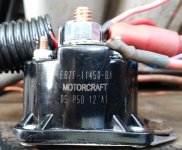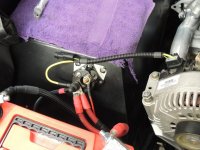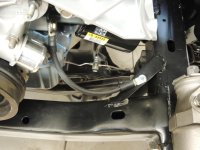- Joined
- Nov 3, 2003
- Messages
- 48,265
I'm curious, is my standard Echlin solenoid limited in it's amp carrying ability - is it a weak link in the circuit if I run 2 gauge in to it and 2 gauge out? It probably would take a series of long cranks to melt it down, right? Thanks, John B
It's only a weak link if it's an inferior, or actually faulty part. But then that does happen a lot these days!
Otherwise no, using larger than normal cable does not add load to the relay's contacts at all. Not unless there was something wrong with your old cables and connections that kept the starter from getting it's full current from the battery in the first place.
It can still become the weak link down the road of course, as things start to go wrong with other components. But not due to larger cables.
The starter, no matter what type it is, only pulls what it needs to crank the engine. So if it pulls for example 100amps under normal circumstances, then whether you have 6ga cable or 2ga cable, the starter relay only sees 100a pass through it. Smaller cables might put more load on it, but I'm not sure how that works. If you had to use an 8ga cable, the cable itself would likely be over-worked, over-heated and in that might cause the relay to work harder. But I'm not really sure. The main sufferer at that point is the cable itself, and not the starter relay I'm thinking.
So no detriment to the relay at this level for using larger cables. Heck, even Ford uses 4ga cables in some applications. Maybe even larger on the diesel trucks with two starting batteries.
You're giving things more headroom by using the larger cables, and giving other components like the starter a boost by not making them work as hard. The larger cables will handle longer and longer cranking without warming up and building up resistance, which would slow down the cranking and put more load on all the other upstream components. They do benefit the starter in that there is no limitation other than it's own, as to what it can pull through the cables from the battery.
If I'm not mistaken, a modern starter is going to use in the range of 75a to 100a to crank a normal V8 engine. An old style would use 120a to 150a typically. And an old tired and failing starter motor, or an engine that has too much ignition timing, or is starting to seize up, could ramp that current up to over 200a just to turn the engine over. At that point everything is taking more current, so it's up to us to make sure it's all capable of handling it.
I could be wrong, but starter relays are probably rated for 250a momentarily. But that's just a guess, as I don't believe I've ever seen a rating. Or if I have I've long since forgotten.
So while the relay/solenoid is "probably" going to be the eventual weak link, if you use a quality one it will probably never fail. But quality is relative these days, and starter relays are among the most failure prone of all the modern replacement parts that we know of.
Craps shoot and luck-of-the-draw, to use gambling terminology.
Maybe Viper or someone can correct any of that info that might be wrong or misleading.
Paul













